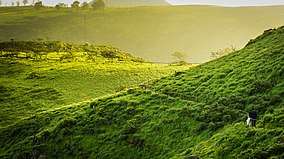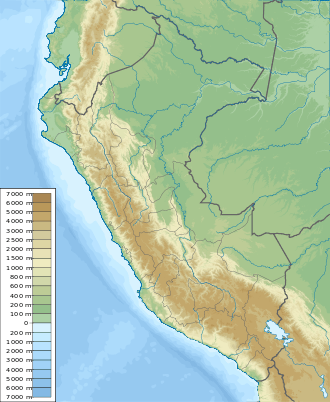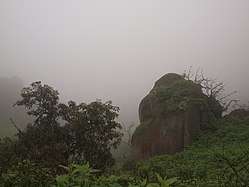Lachay National Reserve
Lachay National Reserve (Spanish: Reserva Nacional de Lachay) is a protected area in the region of Lima, Peru.[2] The reserve is located 105 kilometres (65 mi) north from the Peruvian capital, Lima, and protects part of the lomas ecosystem.[2]
| Lachay National Reserve | |
|---|---|
| Reserva Nacional de Lachay | |
IUCN category VI (protected area with sustainable use of natural resources) | |
 Wet season at Lachay. | |
 | |
| Location | Lima Region |
| Nearest city | Huacho |
| Coordinates | 11°21′30″S 77°22′10″W |
| Area | 5,070 ha (19.6 sq mi) |
| Established | June 21, 1977 |
| Visitors | 30,000 visitors/year [1] (in annual estimate) |
| Governing body | SERNANP |
| Website | Reserva Nacional de Lachay (in Spanish) |
Climate
Climate at the reserve is typical of the lomas: there is a wet season, from June to October (when vegetation develops) and a dry season from January to May (when the landscape is barren).[2][3]
Ecology
The lomas ecosystem consists of areas of coastal desert, mostly hills, that receive enough moisture during winter for plant life to thrive, unlike the drought conditions in summer[3] (except for some El Niño events, that bring rains in the summer).[4]
Flora
Among the native plant species present in the park are: Tara spinosa, Vasconcellea candicans, Ismene amancaes, Verbena litoralis, Vachellia macracantha, Heliotropium arborescens, Armatocereus matucanensis, etc.[2][4]
Fauna

Some birds found in the reserve are: the vermilion flycatcher, the Andean tinamou, the American kestrel, the burrowing owl, etc.[5]
Some mammals found here are: the Sechuran fox, the white-tailed deer, the Pampas cat, the puma, etc.[5]
Archaeology
Pre-columbian archaeological remains have been found in the reserve such as: man-made terraces, cave paintings, tombs and pieces of pottery.[6][2]
Recreation
The main activities in the reserve are birdwatching and hiking.[2] Campsites in the reserve have some amenities like picnic tables, outhouses, parking spots, etc.[2]
Environmental issues
The main environmental issues that threat the integrity of the reserve are: unregulated tourism, firewood extraction, cattle grazing, illegal mining (construction materials), four-wheel drive vehicles outside authorized roads, garbage (not only from visitors, but also from people who toss out garbage from vehicles on the Pan-American highway nearby), invasive species (including stray dogs) and archaeological looting.[7]
References
- "Lachay National Reserve - Park Profile - Threats". www.parkswatch.org. Retrieved 2018-11-07.
- "De Lachay - Servicio Nacional de Áreas Naturales Protegidas por el Estado". www.sernanp.gob.pe (in Spanish). Retrieved 2018-11-07.
- "Lachay National Reserve - Park Profile - Geography". www.parkswatch.org. Retrieved 2018-11-07.
- Cano, Asunción; Roque, José; Arakaki, Mónica; Arana, César; Torre, María La; Llerena, Nelly; Refulio, Nancy (2014). "Diversidad floristica de las lomas de Lachay (Lima) durante el evento "El Niño 1997-98"". Revista Peruana de Biología (in Spanish). 6 (3): 125–132. doi:10.15381/rpb.v6i3.8438. ISSN 1727-9933.
- "Lachay National Reserve - Park Profile - Biodiversity". www.parkswatch.org. Retrieved 2018-11-07.
- "Registro Percepcion arte rupestre Quebrada Palo Lachay Peru". www.rupestreweb.info (in Spanish). Retrieved 2018-11-07.
- "Lachay National Reserve - Park Profile - Threats". www.parkswatch.org. Retrieved 2018-11-08.